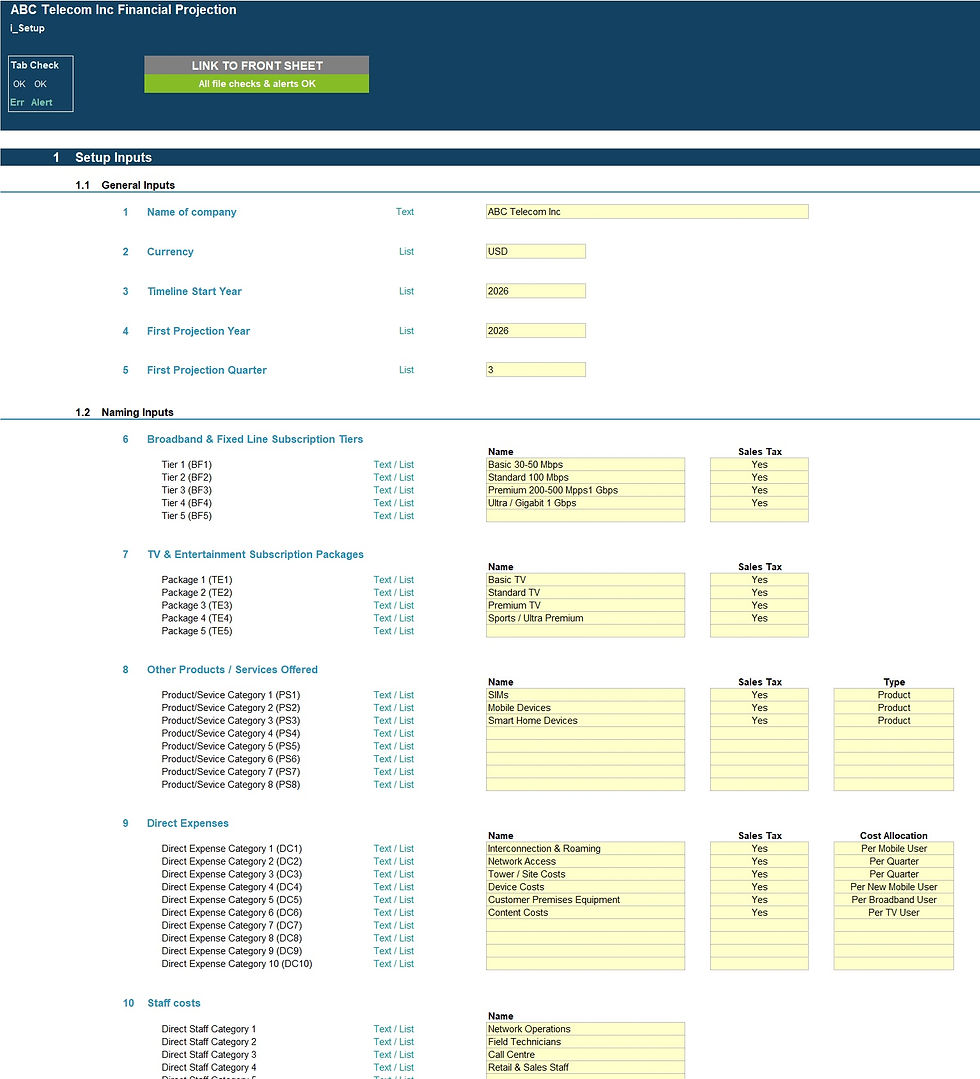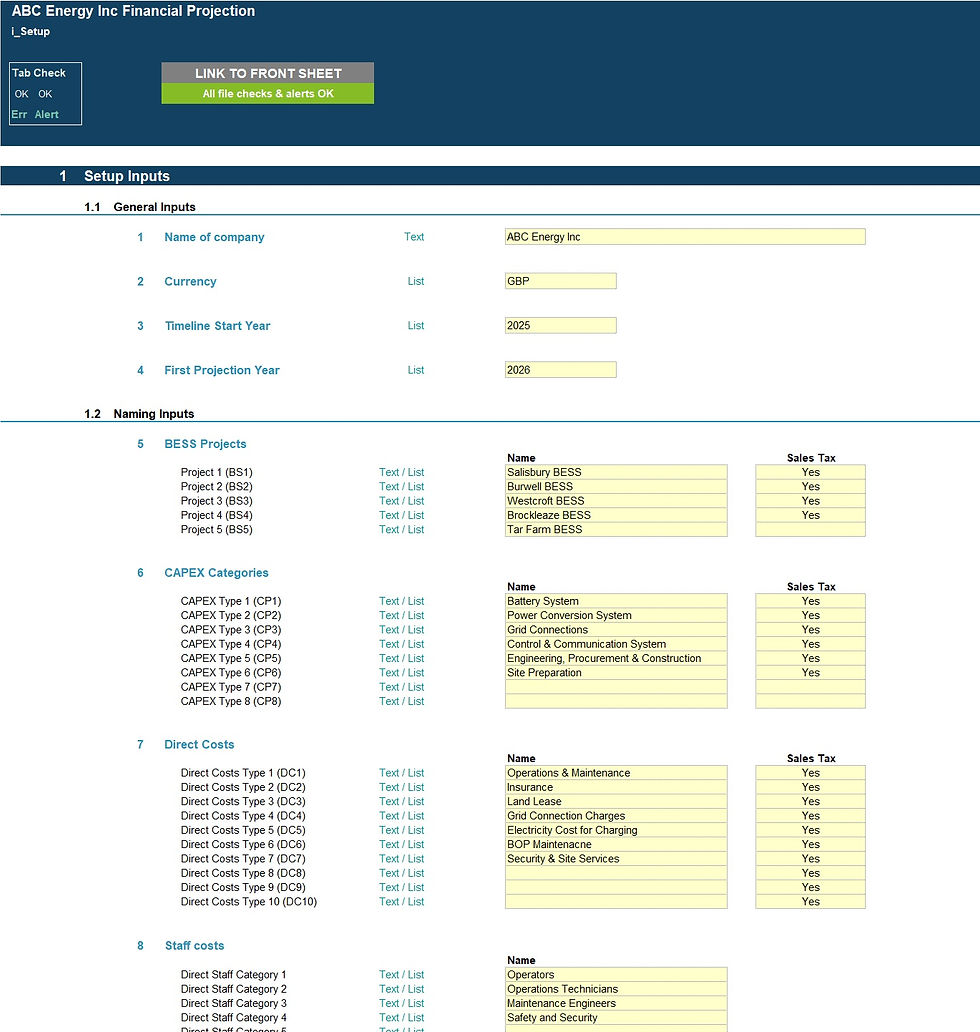PURPOSE OF MODEL
Ship-to-ship (STS) fuel bunkering refers to the process of transferring fuel from one vessel to another while both vessels are afloat, either at anchor or underway. This method of bunkering is commonly used when a receiving vessel requires fuel, and it's not feasible or practical to dock at a port for refuelling.
Our highly versatile and user-friendly Excel model allows for the preparation of a of 5-year rolling 3 statement (Income Statement, Balance Sheet and Cash flow Statement) financial projection with a monthly timeline for a startup or existing fuel bunkering business selling and transferring fuel to other ships.
The model allows the user to model purchase, rental and operation of up 3 separate bunkering ships each with their own voyage volumes, fuel mix, direct expenses and direct staff costs. Apart from revenue and direct costs, the model allows the user to model indirect staff costs, marketing costs, other administrative costs, fixed assets, borrowings, sales tax, corporate tax and dividend distributions.
KEY OUTPUTS
- Projected full financial statements (Income Statement, Balance Sheet and Cash flow Statement) presented on a monthly basis across 5 years and summarised on an annual basis.
- Dashboard with:
- Summarised projected Income Statement and Balance Sheet;
- Compounded Annual Growth Rate (CAGR) for each summarised income statement and balance sheet line item;
- List of key ratios including average revenue growth, average profit margins, average return on assets and equity and average debt to equity ratio;
- Bar charts summarising income statement and balance sheet projections;
- Revenue and gross profit by ship.
- Charts and graphs showing: cash balance by month, free cash flow generation, cash flow statement breakdown, profit margins, income statement breakdown, net cash vs net income, working capital, valuation and capital structure.
- Discounted cash flow valuation using the projected cash flow output.
- IRR and NPV
- Breakeven analysis
KEY INPUTS
Setup Inputs:
- Name of business;
- Currency;
- First projection year and quarter;
- Naming for ships, fuel types, direct expenses, (in)direct staff, direct expenses, marketing costs, staff costs, admin costs, fixed assets and borrowings;
- Sales tax applicability for fuel, direct costs, other expenses and fixed assets.
Actuals Inputs:
- Opening balance sheet (for existing businesses);
- Income Statement actuals (for trend analysis);
Projection Inputs:
- Bunkering ship general assumptions including rent or purchase, in operation or forecast, purchase cost, first and last operating month;
- Fuel assumptions including cost, selling price, safety stock percentage, credit terms received;
- Bunkering ship operating assumptions including number of voyages and fuel mix;
- Direct expenses and direct staff inputs (for each ship);
- Nondirect staff cost inputs including staff numbers, average salary per full time position, average employer’s social security percentage of salary, average annual bonus and bonus payment months.
- Other costs inputs including marketing costs and other operating costs;
- Sales and corporate tax inputs including rate and payment periods;
- Dividend inputs including amount (percentage of retained earnings) and frequency;
- Fixed assets including addition amounts and useful life;
- Borrowings including addition amounts, interest rate and maturity date;
- Share capital additions;
- Discount rate inputs (for valuation calculation).
MODEL STRUCTURE
The model comprises of 9 tabs split into input ('i_'), calculation ('c_'), output ('o_’) and system tabs. The tabs to be populated by the user are the input tabs ('i_Setup', ‘i_Actuals’ and 'i_Assumptions'). The calculation tab uses the user-defined inputs to calculate and produce the projection outputs which are presented in 'o_Fin Stats', ‘o_Dashboard’ and ‘o_DCF’.
KEY FEATURES
- The model contains a flexible timeline that allows for a mix of actual and forecast periods across a 5-year period. This allows projections to be easily rolled forward as forecast periods become actual period;
- Timeline is split on a monthly basis and summarised on an annual basis;
- The model allows the user to model up to 3 separate bunkering ships each with their own volumes, revenues and direct costs.
- The model is not password protected and can be modified as required following download;
- The model is reviewed using specialised model audit software to help reduce risk of formula inconsistencies;
- The model allows for the following number of underlying categories for each line item (these can be easily expanded if required):
- Bunkering ships – 3 ships;
- Fuel types – 5 types;
- Direct expenses – 10 categories;
- Staff costs – 5 direct categories and 5 non-direct categories;
- Marketing costs – 5 categories;
- Other expenses – 15 categories;
- Fixed assets – 5 categories;
- Borrowings – 3 facilities
- Apart from projecting revenue and costs the model includes the possibility to model fixed assets, borrowings (amortising), dividends and corporate tax;
- Business name, currency, starting projection period are fully customisable;
- Revenue, cost and fixed asset descriptions are fully customisable;
- The model included an integrated discounted cash flow valuation using the projected cash flow outputs;
- The model includes instructions, line-item explanations, checks and input validations to help ensure input fields are populated accurately;
- The model includes a checks dashboard which summarises all the checks included in the various tabs making it easier to identify any errors.
SUPPORT / MODIFICATIONS
We are keen to ensure our customers are satisfied and find the models useful for their financial projection needs. Our models are developed with the user in mind and include instructions, line-item explanations, checks and input validations to ensure they are as user-friendly and easy to use as possible without requiring extensive knowledge of Microsoft Excel, finance or accounting. If any questions do arise, we are more than happy to assist. We are also happy to support with any be-spoke modifications you may require to the models to better suit your business needs. To get in touch, please send us a message through the website or contact us on: hello@useprojectify.com
Fuel Bunkering Financial Model - Excel Models
1 Excel model with populated example and 1 blank Excel model




































